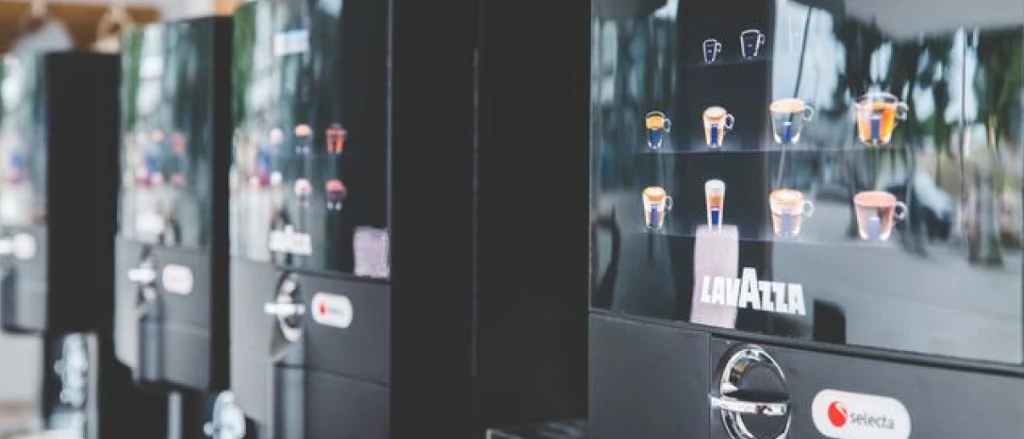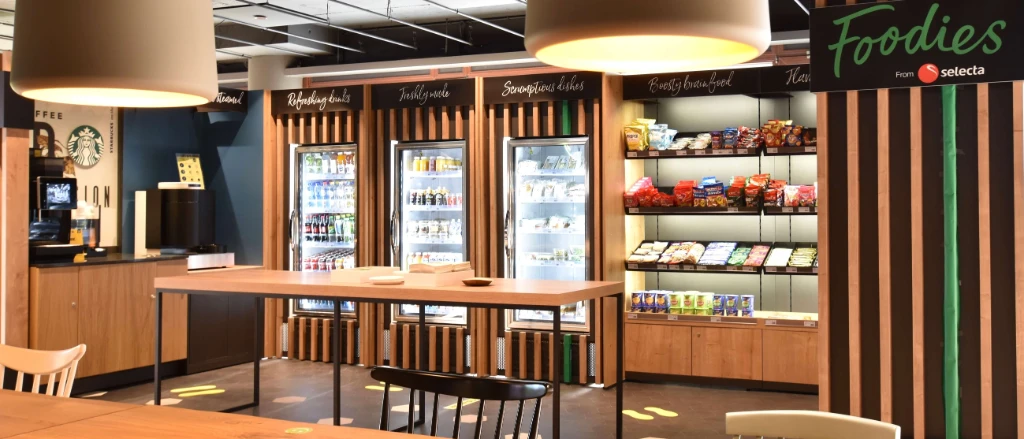Leisure Centre Vending Machines Guide
Catering solutions are vital in places of leisure. Whether it be for indoor leisure activities — like swimming pools, gyms, museums, or activity centres — or outdoor facilities like hiking trails or adventure parks, self-catering solutions play a huge role in changing how visitors enjoy a dining experience.
While it can be tough making the switch from manned stands to a fully self-service catering solution, modern technologies can be added to supplement the dining services of any leisure facilities — boasting a range of benefits.
In this guide, Selecta will cover all the things that leisure facilities need to consider when looking to improve their dining experience with integrated self-service dining solutions, as well as any health and safety and sustainability considerations.
Consumer Considerations
Leisure centres house a variety of different activities and services, so catering solutions need to factor a range of clientele into their service offering – a one-size-fits-all approach to catering doesn’t work in leisure centres.
The modern self-service solutions for leisure facilities will be targeted towards:
- Families
- Site staff — this includes on-site cleaners, management staff and security personnel.
- Children, couples and other customers
- Inspection staff and site mangers — during visitations and evaluations

For these consumers, leisure centre catering managers must consider:
Ease of access — Leisure centres typically have high foot traffic from customers using the facilities. Catering managers must consider where to best place self-service solutions in a way that catch attracts potential customers and provides them with a suitably-sized dine-in space that avoids long wait and traversal times. This includes avoiding second floor catering solutions that may make it difficult for the differently-abled to access.
Variety of goods — Leisure centres house facilities that are used by everybody — and everyone has different needs. As well as housing catering options for younger children, catering managers must also consider how to provide variety to suit a range of preferences — for example, vegan, gluten-free or allergen-free options.
Religious and cultural options — As leisure centres house facilities designed for all, the dining options should reflect this. Any self-service or micromarket solutions should be equipped to house different types of food to accommodate different cultures — for example, halal meat and kosher options — to expand their service offering to all cultural and religious dietary preferences.
Convenience — Part of a self-service solution is convenience — if it isn’t convenient, it will ultimately defeat the purpose. Catering managers need to take care when deciding on the best equipment to offer the broadest range of hot, cold, healthy or fast-food options in the space available.
Site Considerations
Making the leap and installing state-of-the-art self-service solutions can save you money in the long-term while leaving customers happy and satisfied. However, if these solutions are not custom-fit to the floorplan, it can harm your catering reputation rather than help it.

Some of the site considerations that leisure centre catering managers need to focus on are:
Space — For some smaller leisure facilities, it can be difficult to put in an all-encompassing catering solution. It’s up to the catering managers to decide what machines best use the space and provide the most variety and convenience for the consumer as possible.
Availability — With some larger leisure centres — that house many different facilities across a large space — availability for consumers becomes a priority to consider. To stop hundreds of visitors traversing long distances, catering managers must consider how they can either spread their catering solutions across the facility — in the form of micro hubs — or create a larger self-service dining space that’s as close as possible to all the centre’s attractions.
Consumer satisfaction — Because space determines the type, range and amount of self-service catering solutions you can offer, catering managers must consider how to best utilise the space to maximise the number of diners that can use them while still making it a pleasurable and comfortable experience.
Health and safety considerations
Catering managers may have drawn up the perfect plan on how a solution might fit into the space, but if it doesn’t comply with health and safety regulations, it would have all been for nothing.
Failing to adhere to health and safety regulations will not only land leisure centres with fines and even closure orders, but also puts visitors at risk.
Some of the health and safety considerations worth bearing in mind are:
Product storage and rotation — Chilled and hot food both have stringent rules surrounding their shelf life. Leisure centres are a focal point for consumer traffic — with many being young children — so, food safety is paramount. Products need to be regularly rotated and stored appropriately prior to going on sale to avoid cross-contamination.
Installation safety — It’s vital that before any self-service catering solution is set up, catering managers should conduct a thorough risk analysis to guarantee consumer safety. For example, self-service machines or micro markets must not block fire exits, be secured in place to avoid them tipping over and have any electrical wiring covered or hidden to prevent trip hazards.
Signposting hazards — Consumers need to be aware of hazards in and around dangerous machinery. Catering managers must assess the risks — for example, burns, scald or trip hazards — and signpost them appropriately. This is especially important for leisure centres because children may also occupy theses spaces.
Legal documents — Machines need regular maintenance checks to earn them a “pass certificate” — meaning they’re safe to use. These must be up-to-date to show the machines are safe to use and that any faults that may cause harm are be tackled quickly.

Leisure facility catering regulations
When installing a self-service catering solution in leisure centre, catering managers must make sure they adhere to stringent leisure centre catering regulations.
Firstly, any self-service catering solution must they follow strict Food Standards Agency (FSA) guidelines. This means training staff on proper food storage and preparation as well as rotating stock each day.
Secondly, the law requires regular maintenance of any:
- Gas appliances
- Flues
- Pipework
- Self-service devices
This guarantees the that the machines are safe and pose minimal risk to consumers.
Sustainability considerations
With the environment playing an increasingly important role in governing business decisions, catering must follow suit and look to make as many changes as possible to do their part.

Catering managers need to consider:
Cutting waste — Whether people grab-and-go or dine in, there is always waste left over that can be reduced with some planning. Catering managers must consider how food in the machines is packaged — for example, using recyclable or compostable materials — as well as deciding whether to provide reusable cutlery or offer a sustainable alternative.
Reducing energy output — Having efficient machines that can power down during periods of little use and have a higher energy efficient rating can help slice emissions and cut down on costs in the long term.


Our 50+ team of international selecta product experts will answer your request
Message Sent Successfully
Thank you! Your message has been received. We’ll get back to you soon.
Something Went Wrong
We couldn’t send your message. Please try again, or come back in a moment.

-min.webp)
